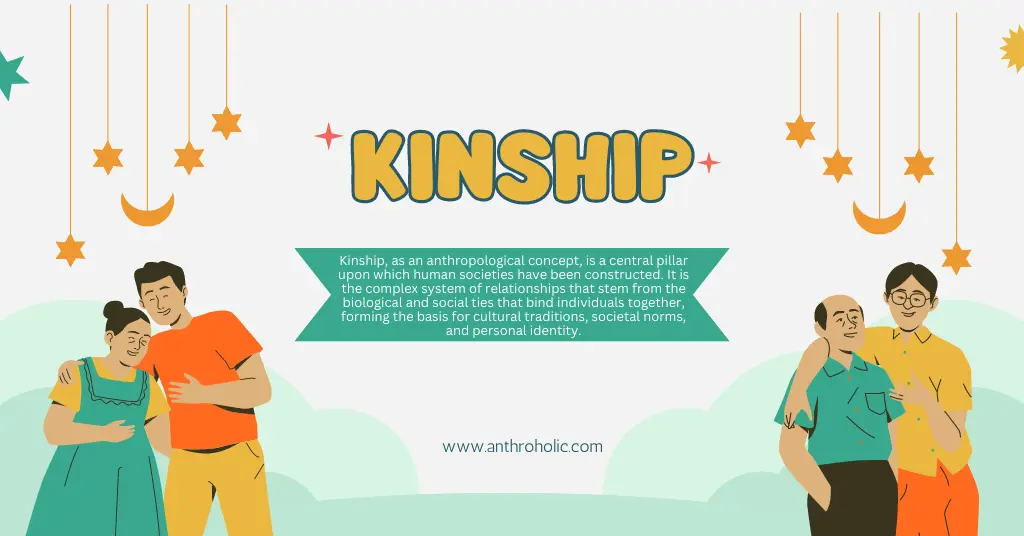AI Answer Evaluation Platform Live Now. Try Free Answer Evaluation Now
Kinship
Kinship, as an anthropological concept, is a central pillar upon which human societies have been constructed. It is the complex system of relationships that stem from the biological and social ties that bind individuals together, forming the basis for cultural traditions, societal norms, and personal identity. From the family nucleus to vast, intricate clans, kinship is the thread that weaves together the tapestry of human social existence.

Kinship provides individuals with a sense of belonging and plays a critical role in our lives, helping to define roles and responsibilities within the community, inform social behavior, and regulate interpersonal interactions (Ingold, 2011). It’s a primary means of social organization, influencing everything from marriage customs to economic transactions to political alliances.
Kinship: An Overview
Definition of Kinship
In the broadest sense, kinship can be defined as the recognition of relationships between individuals based on descent (real or imagined) and marriage (Holy, 1996). It involves the study of lineages and family units, delineating the cultural and societal rules that govern the interpersonal dynamics within these groups.
The Basis of Kinship
There are primarily three bases of kinship:
- Blood Relation (Consanguinity): This refers to kinship through shared genetic heritage, such as parents and children, siblings, and extended relatives (nephews, nieces, cousins, etc.).
- Marriage (Affinity): This form of kinship is based on marriage bonds, extending to spouses and their families.
- Adoption (Fictive Kinship): This involves individuals who are not biologically related or related by marriage, but are still considered family due to societal, personal, or legal bonds.
Types of Kinship
There are several ways to classify kinship. Here’s a breakdown:
| Types of Kinship | Definition |
|---|---|
| Affinal Kinship | Formed by marriage, such as between spouses, or between siblings and their spouses. |
| Consanguineous Kinship | Formed by common ancestry or descent. |
| Fictive Kinship | Formed by non-biological relationships, such as adoption, godparenting, or close friendships that take on familial significance. |
Kinship Terms
The language we use to describe our relationships reveals much about the way we perceive and value these bonds. Here’s a glimpse into a few common kinship terms:
- Ego: The point of reference from which kinship relationships are viewed.
- Collateral: Kin who are descended from the same ancestor as Ego, but not in a direct line of descent.
- Lineal: Kin in the direct line of descent or ascent of Ego.
- Parallel Cousins: Children of same-sex siblings.
- Cross Cousins: Children of opposite-sex siblings.
Kinship Systems Around the World
Kinship systems can vary vastly across different cultures, reflecting unique societal structures, norms, and values. Let’s take a look at some examples:
Eskimo Kinship System
The Eskimo system, used in many Western societies, emphasizes nuclear families. It differentiates between lineal relatives (direct ancestors or descendants) and collateral relatives (such as cousins, aunts, uncles) (Murdoch, 1949).
Hawaiian Kinship System
This system is the simplest and most “classificatory.” It only distinguishes between genders and generations. All members of a generation are considered siblings, regardless of their biological closeness (Keesing, 1981).
Sudanese Kinship System
The Sudanese system is the most complex, with separate terms for each individual family member based on gender, generation, lineage, and relative age (Kroeber, 1909).
The Influence of Kinship on Societal Structure
Kinship systems can shape societal structures in profound ways.
- Marriage Rules: In many societies, kinship determines who one can and cannot marry. For instance, in some cultures, cross-cousin marriage is encouraged, while parallel cousin marriage is considered incestuous.
- Inheritance and Succession: Kinship can influence the division of property and wealth, as well as determine the line of succession for leadership roles.
- Social and Economic Networks: Kinship networks can facilitate business partnerships and economic exchanges, creating social safety nets and opportunities for upward mobility.
Conclusion
Kinship is more than just a record of who is related to whom. It is a complex and dynamic system that encapsulates human relationships and interactions, shaping societal structures and informing cultural norms and traditions. As such, it is a fascinating and critical field of study in anthropology, sociology, and related disciplines.
References
- Holy, L. (1996). Anthropological Perspectives on Kinship. London: Pluto Press.
- Ingold, T. (2011). The Perception of the Environment: Essays on Livelihood, Dwelling, and Skill. London: Routledge.
- Keesing, R. M. (1981). Cultural Anthropology: A Contemporary Perspective. Holt, Rinehart and Winston.
- Kroeber, A. L. (1909). Classificatory Systems of Relationship. Journal of the Royal Anthropological Institute of Great Britain and Ireland, 39, 77-84.
- Murdoch, G. P. (1949). Social Structure. New York: The Free Press.



